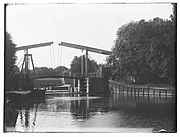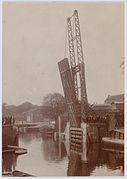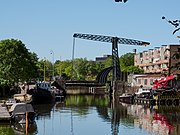History
The bridge was made by Werkspoor op Oostenburg. In 1911, the controls were given electric power with a drive from the NB Haarlemsche Machinefabriek v / h / Gebr. Figee. Some repair work had to be done in 1936, but the bridge has done its job perfectly since its placement. However, today the bridge is controlled in the same way as the adjacent bridge 327, which resulted in a saving on the lubrication frequency from 10 times a month to once every quarter.
According to Smit van Wichert, the designer was Arend de Graaf and belongs to his first generation of drawbridges. Very few of them are left because they became outdated and looked somewhat crude. In the years following the construction of this bridge, De Graaf's drawbridges became somewhat more ornate, so the movement work became open (it is closed at bridge 80). It was not until 1915 that the definitive De Graaf drawbridge took its shape under the influence of structural engineer Adriaan Dwars. The end result of all improvements can be found in bridge 307, the result of a collaboration with Piet Kramer.
Double wooden drawbridge established by Jacob Olie in 1891
Daylight print made by industrial photographer Gustaaf Oosterhuis (1858-1938) of the drawbridge in the Hoogte Kadijk, ca 1902
The bridge in May 2017

The River Ancholme is a river in Lincolnshire, England, and a tributary of the Humber. It rises at Ancholme Head, a spring just north of the village of Ingham and immediately west of the Roman Road, Ermine Street. It flows east and then north to Bishopbridge west of Market Rasen, where it is joined by the Rase. North of there it flows through the market town of Brigg before draining into the Humber at South Ferriby. It drains a large part of northern Lincolnshire between the Trent and the North Sea.

The Welland Canal is a ship canal in Ontario, Canada, and part of the St. Lawrence Seaway and Great Lakes Waterway. The canal traverses the Niagara Peninsula between Port Weller on Lake Ontario, and Port Colborne on Lake Erie, and was erected because the Niagara River—the only natural waterway connecting the lakes—was unnavigable due to Niagara Falls. The Welland Canal enables ships to ascend and descend the Niagara Escarpment, and has followed four different routes since it opened.

The Dortmund–Ems Canal is a 269-kilometre (167 mi) long canal in Germany between the inland port of the city of Dortmund and the seaport of Emden. The artificial southern part of the canal ends after 215 kilometres (134 mi) at Herbrum lock near Meppen. The route then takes the river Ems for 45 kilometres (28 mi) to Oldersum lock. From there, the canal continues along a second artificial segment of 9 kilometres (6 mi). This latter section was built because inland ships at the time of the construction of the canal were not built for the open sea, which they would have faced at the Dollart and the entry to the sea port of Emden. It is connected to the Ems-Jade Canal from Emden to Wilhelmshaven.

Van der Valk is a British television crime drama series produced for the ITV network by Thames Television. It ran from 13 September 1972 to 19 February 1992, with the first three series produced between 1972 and 1977, and two more being commissioned in 1991 and 1992.

Barmouth Bridge, or Barmouth Viaduct is a Grade II* listed single-track wooden railway viaduct across the estuary of the River Mawddach near Barmouth, Wales. It is 900 yards (820 m) long and carries the Cambrian Line. It is the longest timber viaduct in Wales and one of the oldest in regular use in Britain.

Navigable aqueducts are bridge structures that carry navigable waterway canals over other rivers, valleys, railways or roads. They are primarily distinguished by their size, carrying a larger cross-section of water than most water-supply aqueducts. Roman aqueducts were used to transport water and were created in Ancient Rome. The 662-metre (2,172 ft) long steel Briare aqueduct carrying the Canal latéral à la Loire over the River Loire was built in 1896. It was ranked as the longest navigable aqueduct in the world for more than a century, until the Magdeburg Water Bridge in Germany took the title in the early 21st century.

The Rhine–Herne Canal is a 45.6-kilometre-long (28.3 mi) transportation canal in the Ruhr area of North Rhine-Westphalia, Germany, with five canal locks. The canal was built over a period of eight years and connects the harbour in Duisburg on the Rhine with the Dortmund-Ems Canal near Henrichenburg, following the valley of the Emscher. It was widened in the 1980s. The Rhein-Herne canal ship was designed specifically for this canal; normally of about 1300–1350 ton capacity, it has a maximum draft of 2.50 metres (8.2 ft), a length of approximately 80 metres (260 ft), and maximum beam of 9.50 metres (31.2 ft).

Karl Johansslussen is a lock and a sluice, along the Söderström river connecting and controlling the flood discharge between Riddarfjärden, the easternmost part of Lake Mälaren, and Saltsjön, the section of the Baltic Sea reaching into central Stockholm, Sweden. The lock is 75 metres long, 10 metres wide and 3.90 metres deep. The maximum height is 3.8 metres. The lock is closed from 2016 to 2021 due to large reconstruction works in the area.
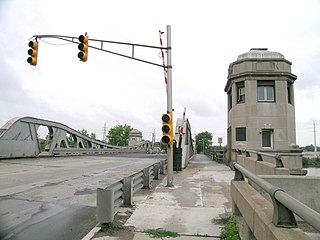
The West Jefferson Avenue–Rouge River Bridge is a historic double-leaf bascule bridge in Wayne County, Michigan, at the border of the cities of Detroit and River Rouge. The bridge carries Jefferson Avenue, a major thoroughfare in Southwest Detroit, over the River Rouge, an important inland route for lake freighters. The bridge was built in 1922, and was listed on the National Register of Historic Places in 2000.

The Langlois Bridge at Arles is the subject of four oil paintings, one watercolor and four drawings by Vincent van Gogh. The works, made in 1888 when van Gogh lived in Arles, in southern France, represent a melding of formal and creative aspects. Van Gogh used a perspective frame that he built and used in The Hague to create precise lines and angles when portraying perspective.
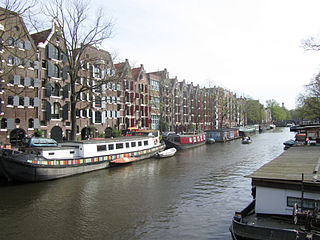
The Brouwersgracht is a canal in Amsterdam that connects the Singel with the Singelgracht. The canal marks the northwestern border of the Grachtengordel. Between the Prinsengracht and the Singelgracht the Brouwersgracht forms the northern border of the Jordaan neighborhood.
Sint Servaasbrug is an arched stone cyclist and pedestrian bridge across the river Meuse in Maastricht, Netherlands. It is named after Saint Servatius, the first bishop of Maastricht, and it has been called the oldest bridge in the Netherlands.
The Kadijken, also known as Kadijkseiland or Kadijkenbuurt, is a neighbourhood to the north of Artis zoo in the centre of Amsterdam. The name Kadijken is the plural form of Kadijk and refers to the two main streets that traverse the neighbourhood, Hoogte Kadijk and Laagte Kadijk.

Vlotbrug translates from Dutch into English as "raft bridge". It is a special kind of floating Retractable bridges at the Great North Holland Canal which pivot either centrally or from one or both banks of a body of water to allow vessels to pass through.
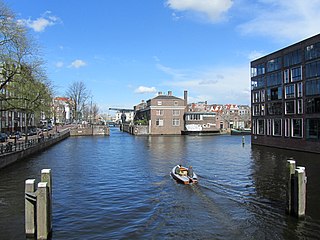
The Nieuwe Herengracht is a canal in Centrum district of Amsterdam. The canal is an extension of the Herengracht that runs between the Amstel and the Scharrebiersluis (lock) leading to the Schippersgracht from the Entrepotdok. It is in the Plantage neighborhood in the eastern part of the Grachtengordel.
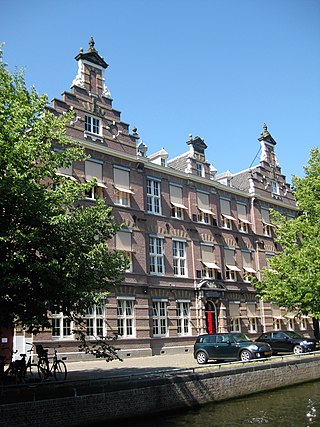
The Nieuwe Prinsengracht is a canal in the Plantage neighborhood of Amsterdam, an extension of the Prinsengracht in the eastern Grachtengordel.

The Oudezijds Voorburgwal, often abbreviated to OZ Voorburgwal, is a street and canal in De Wallen in the center of Amsterdam. It runs from the Grimburgwal in the south to the Zeedijk in the north, where it changes into the Oudezijds Kolk, which drains into the IJ.

The Entrepotdok, formerly Nieuwe Rapenburgergracht, is a canal in Amsterdam, and a street and row of former warehouses with the same name along the northeast side of the canal. They were constructed between 1708 and 1829, used for storage, squatted in the 1990s and are now converted into apartments. Entrepotdok is the largest inhabited warehouse complex in Amsterdam. The canal runs between the Kadijksplein and Sarphatistraat, and is parallel to Hoogte Kadijk, Laagte Kadijk, Plantage Doklaan and Natura Artis Magistra zoo.

The Nieuwe Vaart or Nieuwevaart is a 17th-century canal in Amsterdam that runs from the center to Amsterdam-Oost.
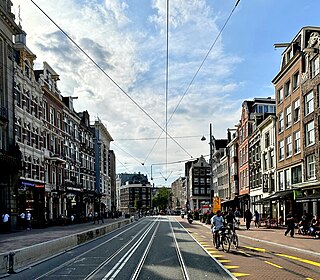
Martelaarsgracht is a street and former canal in Amsterdam, the Netherlands.


